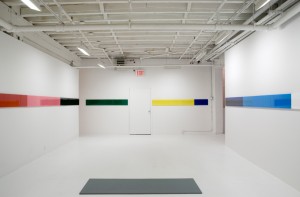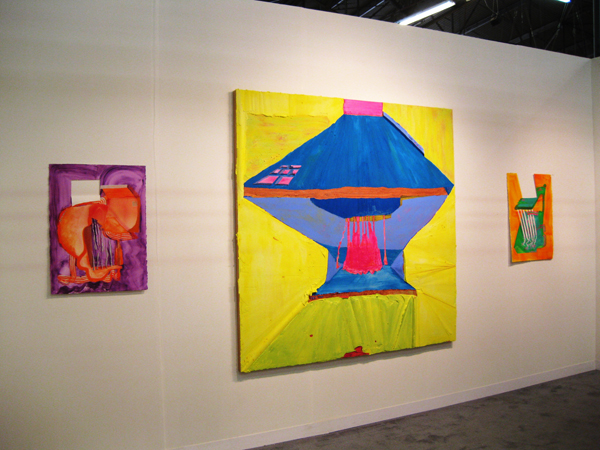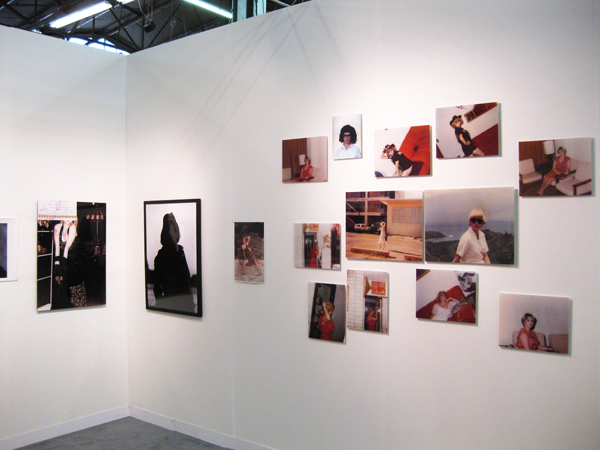
Amanda Schmitt begins this interview series with a highly intellectual conversation with Egan Frantz, whose first New York solo exhibition is currently on view at Cueto Project.
Revision 1: All Quiet on the Western Front. What a heavy exhibition title! It is loaded with various allusions and pre-conceived connotations, yet the “Revision 1″ addition leaves everything open and unexplained. Now, to be honest, I have never read the novel nor seen the film adaptation, and my knowledge of this story extends to what Wikipedia and imdb.com have provided me with. Can you please give me, in your words, a brief, objective summary of this novel?
Most people I have spoken with, having read the book/seen the film(s) or not, come to the exhibition knowing there is this war story. In this regard the title carries a kind of automatic weight which I hoped to set against certain lightness. The exhibition is situated on the western front of Manhattan, or, almost, it’s up against the West Side Highway. Before anything, one feels a breeze of speeding vehicles… I find a certain humor in this. As metaphor the title might suggest a certain silence in the history of western thought, and it is important for me that all this can all happen before opening the door or having never opened the book. Inside, the music sounding from the back room of the gallery is always present, perhaps to the point of being aggressive. If you really want to sink your teeth into the footnotes, the introduction of ’silence’ came only through the novel’s subsequent translation into English. The original German title, “Im Westen nichts Neues,” makes no mention of silence. There is then this idea of a continuous project, rephrasing or translation in “Revision…” The title points both inward and outward, locating the textual and the ‘non-textual’. Or you can just walk in you know?
I really want to make work that can be read on its own terms at the same time offering itself to some potential, persistent reader. The novel itself is a kind of educational shoe… me and my friends read it growing up… My good friend Luca Dellaverson can recite the preface off the cuff:
“This book is neither an accusation nor a confession, and least of all an adventure, for death is not an adventure to those who stand face to face with it. It will try simply to tell of a generation of men who, even thoughthey may have escaped shells, were destroyed by the war.”-Erich Maria Remarque (1928)
This exhibition is very visual…it requires a lot of effort on the eyes. There is one section that blasts club music, yet, because of the bright lighting and lack of other bodies, doesn’t make me feel like dancing at all. How do you feel this noise may or may not affect the way the viewer interacts with the framed pieces on the wall? For me it was unsettling, and made it difficult to concentrate on what I was looking at. In fact, I felt a little confused. What are these numbers? Why am I not able to discern any recognizable figure within this field? Did the bass from the amp jumble up the printed numbers on the paper so that they are now scattered and crooked? Are these two separate pieces that happen to be in the same room, or is this a cohesive installation?
The work you are referring to is 13 Figures and K.I.T.T.Y. Jam, an installation which I like to think of as playing “call and response” between this amazing Eddie Def electrofunk mashup and my 13 figures. A “jam” is what we used to call an old school hip-hop track, and it also brings to mind fresh-fruit preserves (FRESHHH – remember that sample?) which are, of course, “mashed up.” Language or ‘that which is received’ is the generator here and always in my work. I might also just say I like the way Eddie works with constraint at the same time keeping things totally wild, in outer space. My decision to make 13 works using only the numbers 1-13 comes from a similar impulse.
Within the larger context of the exhibition the way the audio travels around the space does something very important for me – it’s like seeing through walls – which is to supply a connective tissue between each and every work in the exhibition.
Please tell me more about “MK, PK, LK, LLK, C, M, LC, LM, Y,” a piece that is visually compelling and surprisingly seductive. What printer did you use? What kind of paper is this? I understand that you used CMYK cartridges, correct? What was the exact model? Also, how many cartridges did you have to go through for each piece?
I have an Epson Pro 3800, the smallest version of their large-format printers. It uses the same inks as the big ones but is only 17 inches wide and fits in my little Chinatown studio. The engineers at Epson designed a palette based on CMYK with steps in between. I simply command the printer to print each value, the thing is, the printer mixes nearly all the inks to produce each figure. If it looks like an attempt to deconstruct the inkjet image, it is just that, an attempt. It only feigns its own success as some kind of exercise in purity. They are printed on a paper made by Ilford called Galerie Gold Fibre Silk and I made the entire work without swapping cartridges. If you like the piece formally, props to Epson and Ilford.
I LOVE the piece formally. I am a CMYK-LOVER. Props to Epson and Ilford! Material is clearly important to you. The description of the medium for each piece on the checklist goes on for several lines. Some artists just opt for “mixed media.” Why is your work not just “mixed media”?
Trained as a photographer in school I was led down a particularly Barthesian path. In Camera Lucida Barthes comes to many things, one of these being that every Photograph is a certain proof, “like the delayed rays of a star.” This might not be the case for inkjet prints, which are produced by something more like a painting machine than any assortment of darkroom (chemical / light) processes, but I’m not lost on this. I use materials as proofs towards a kind of mute speech via their associative qualities or the way these things sound or look in language itself. The materialist lists / titles are tools to get into the work. They also make very clear the impossibility of a complete description. Jared Madere has nice way of putting this, “I don’t say whether or not my window was open when I made the work.”
As in Petroleum Pictures, we are told that the plastic parts come from Canal Plastics Center. What if they had been mail ordered? Would it not be the same piece to you? As for the piece in the center of the room, made with 18% reflective middle gray book cloth, how would the piece change if it was 81% reflective?
I have a nice anecdote to get somewhere close to an answer. The nice girls who work at the gallery were getting really tired of the music which plays rather loudly 10am-6pm, 5 days a week. I wanted to make some sort of gesture to express my gratitude to them, so the next day I went to Canal Rubber (just down the block of Canal Plastics), bought some acoustic foam, that I later cut to the same size as this middle grey stage you were describing, before swapping the former for the latter. The Petroleum Pictures room is situated between the 13 Figures… and their respective desks. Of course, they’re still dealing with music, but surely the acoustic foam is sucking up some sound on its way over! I’m especially fond of this move for the way these two rooms, when taken together, present a kind of aporia — one projecting and the other sucking.
The Sidesteps series were made by taking a squeegee to freshly printed digital images, however they very much have a “darkroom” quality to them. They remind me of Wolfgang Tillman’s photographic abstractions, made by manipulated photo chemicals directly onto the paper during the development process. How did you come about making this series? What it a happy accident or a calculated, conceptual process?
For me and many others the word ‘conceptual’ is bound up with a specific historical moment, that is, ‘conceptual art,’ and I think it functions best this way, as descriptive of a moment in time. I make use of systems to get myself out the work and avoid making too many arbitrary decisions, but, when making objects, it becomes increasingly clear how pathos continues to creep in. The late Jack Spicer has this character called Lowghost who is often creeping into his books. I like this idea of logos as a kind of gremlin in his work.
Regarding the Sidesteps, there is a lot of information this work (it is an ongoing project) which I could easily go on listing. Lately, I’ve been interested to see how the sequence functions without my voice all over it. The tools are there in the titles, materials, numbers, sizes, etc. As far as process goes these things are very simple. Using a squeegee has nothing to do with some sort of affinity towards the tool and the result it produces. It’s a matter of treating the inkjet print like its gelatin silver predecessor. Treating one object like another – this is key. In the darkroom one would normally squeegee their prints in kind of final gesture before laying them out to dry. I use this same squeegee and do the same thing when a print comes fresh out of the inkjet printer. Naturally, this produces a distinctly different result every time, so as R.H. Quaytman likes to say, “to pierce the ego of their singularity,” I repeat this process 11 times and display each result.
It was the image I used for the first sequence Sidesteps (source: chaos_and_creation.jpg) that was helpful in determining the system I continue to use. I used a still from a video in which Dali is having an argument with Mondrian about pure ‘painting’ vs ‘corrupted’ painting… I wanted to pull this whole idea to the side. In doing so I ended up making a kind of horizontal move into painting myself.
Let’s talk a little bit about “Untitled…” (the one made out of PMMA). This work can read in many different ways; it is a different piece each time a different person views it. This here is a fact, since the reflection changes with each new body that stands in front of the piece. Now, the viewers can be grouped into two categories: those who look atUntitled… and see through the first layer of PMMA and try to look at the interior of the three-dimensional object (a sculpture), and those who look at the surface of the PMMA, ignoring the side of the box (a quasi-painting). If you had to categorize Untitled…, would it be a painting or a sculpture?
Would it be helpful for you if I categorized it?
No. That wasn’t a good question. In fact I should probably delete, but I like the moxy in your response. And no, it wouldn’t be helpful. I all for the subjective….To me, the piece is open-ended because it can be a piece about materiality, formal compositions, transparent interchanges, self-reflexivity, etc…the list goes on. Is this piece as open-ended to you as it is to me? Or rather, are you trying to communicate something specific to the audience?
Yes it is definitely open ended, at least more overtly than the others. There was a point where I was calling it “a nothing” to my friends but this went into some funky Ray Johnson territory, and I don’t want to step on Ray Johnson.
What are you Mr. Frantz, a photographer a painter? You to seem to fit in between the two. You are not taking images with a camera, or creating them with a brush, but rather a “chooser” and “manipulator” of images. You seem to control how your audience sees an image. As in MK, PK, LK, LLK, C, M, LC, LM, Y, we are looking at pure color, yet that color, or image, could have come from anywhere! The MK could be a microscopic view of someone’s black tuxedo, or a macroscopic view of the night sky. Or perhaps, it is just ink on paper. Or in Remarque, Erich Maria, you present the viewer with a photocopy of a photograph. Would you reject my assumption that you are a curator of images? Are they YOUR photographs, or do they come from somewhere else? Are your manipulated inkjet prints your paintings?
I was recently invited to participate in a book project happening out in LA. Shortly after confirming my participation they sent out of PDF list of participating artists. In that list, it says Egan Frantz – Painter. The function of a curator is so contested these days I’m not sure what you mean when you ask if I consider myself a curator of images. I can tell you that if there is any one object I have a particular affinity towards it is the radio. I would really like to be a radio, to transmit that which comes from the outside, and do this very well!
You know, my brother, a nuclear engineer and an avid logophile (lover of words and definitions), loves the fact that I describe myself as a curator. Before looking it up in a dictionary, he didn’t know what a “curator” was. And now, to him, I am “an ecclesiastic entrusted with the cure of souls.” Basically what I’m trying to say is that although there may be a definition in Webster’s, the term is as you said, highly contested and absurd. ???To wrap things up, how does Revision 1: All Quiet on the Western Frontrelate to All Quiet on the Western Front (your first solo exhibition)? Will there be a Revision 2?
I can’t say if there will be a Revision 2 but surely the next exhibition will function that way – as a continuous revision of what is already out there. I came to Revision 1 for a number of reasons, one being that I had had my undergraduate exhibition at Hampshire College a little less than a year before and still felt that I was sweating out a number of the same problems. A good deal of this show is comprised of things I made in school, which is a nice glance back to this narrative of school boys in Erich Maria Remarque’s novel. It is my hope that through these exhibitions I’ve built something like a solid stage. If this is true, the next thing I should be able to do is walk all over it.
Right now I’m really excited about the Guatemalan writer Augusto Monterroso. Some of his stories are as short as one sentence as in The Dinosaur, “When I woke up, the dinosaur was still there.” This little structure is endlessly playful. Again, we are dealing with a translation and in this case the “I” is interchangeable with “he” and “she”. I have a pretty intense relationship to sleep (I sleep more than any one I know) and I am still something of a bedroom artist (I share my studio with my bed), so, yes, something along these lines is happening for me…






 RSS
RSS
